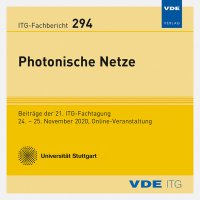Flexible Nyquist pulse sequence generation from an integrated slow-light silicon modulator for elastic network applications
Konferenz: Photonische Netze - 21. ITG-Fachtagung
24.11.2020 - 25.11.2020 in online
Tagungsband: Photonische Netze
Seiten: 5Sprache: EnglischTyp: PDF
Autoren:
Misra, Arijit; Schneider, Thomas (THz Photonics Group, Technische Universität Braunschweig, Braunschweig, Germany)
Hosseini, Reza; Dev, Sourav; Jamshidi, Kambiz (Integrated Photonic Devices Lab, Technische Universität Dresden, Dresden, Germany)
Inhalt:
Today, 100 Gbit/s Ethernet is already in use for high-performance computing and in datacenters. However, due to the growing demand, it has to be scaled to 400 Gbit/s, 1 Tbit/s and even beyond. Because of the required energy-efficiency and the widely available bandwidth along with elasticity in network allocation within limited network resources, optics offers better solutions than electronics. Optical time domain multiplexing with optically sinc shaped Nyquist pulse sequences can reduce the signal bandwidth to the symbol rate without intersymbol interference. Due to the rectangular shape of the spectrum, no guard band is required and it provides a greater flexibility in networking with enhanced spectral efficiency. Most importantly, the generated pulses can be three to four times shorter than the inverse of the bandwidth of the used modulators. Thus, even with low bandwidth integrated silicon modulators, very short pulses can be generated. These short pulses can be used to transmit high data rate signals with a PAM-4 modulation, or other higher order formats. Additionally, it enables the possibility to generate Nyquist pulse sequences with flexible bandwidth and repetition rate, which is essential for elastic networks and many other applications. Moreover, these pulse sequences can be also used for signal processing, computing, analog/digital conversion etc. Recently various groups around the world have reported sinc pulse sequence generation using integrated silicon modulators. In this work we will review these attempts and will present sinc pulse sequence generation from an ultra-compact, slow-light silicon intensity modulator with an extinction ratio of more than 30 dB and VπL of 3 V-cm. The size of the used modulator is by far the smallest among the reported ones.


